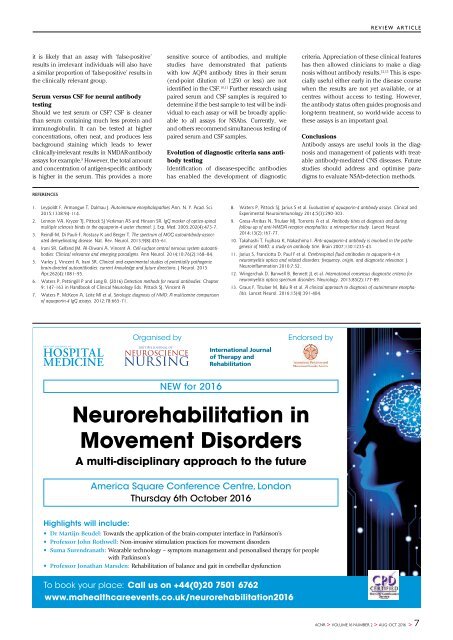In this issue
ACNR-ASO16-full-pdf-2
ACNR-ASO16-full-pdf-2
Create successful ePaper yourself
Turn your PDF publications into a flip-book with our unique Google optimized e-Paper software.
e v i e w a r t i c l e<br />
it is likely that an assay with ‘false-positive’<br />
results in irrelevant individuals will also have<br />
a similar proportion of ‘false-positive’ results in<br />
the clinically relevant group.<br />
Serum versus CSF for neural antibody<br />
testing<br />
Should we test serum or CSF? CSF is cleaner<br />
than serum containing much less protein and<br />
immunoglobulin. It can be tested at higher<br />
concentrations, often neat, and produces less<br />
background staining which leads to fewer<br />
clinically-irrelevant results in NMDAR-antibody<br />
assays for example. 9 However, the total amount<br />
and concentration of antigen-specific antibody<br />
is higher in the serum. This provides a more<br />
sensitive source of antibodies, and multiple<br />
studies have demonstrated that patients<br />
with low AQP4 antibody titres in their serum<br />
(end-point dilution of 1:250 or less) are not<br />
identified in the CSF. 10,11 Further research using<br />
paired serum and CSF samples is required to<br />
determine if the best sample to test will be individual<br />
to each assay or will be broadly applicable<br />
to all assays for NSAbs. Currently, we<br />
and others recommend simultaneous testing of<br />
paired serum and CSF samples.<br />
Evolution of diagnostic criteria sans antibody<br />
testing<br />
Identification of disease-specific antibodies<br />
has enabled the development of diagnostic<br />
criteria. Appreciation of these clinical features<br />
has then allowed clinicians to make a diagnosis<br />
without antibody results. 12,13 This is especially<br />
useful either early in the disease course<br />
when the results are not yet available, or at<br />
centres without access to testing. However,<br />
the antibody status often guides prognosis and<br />
long-term treatment, so world-wide access to<br />
these assays is an important goal.<br />
Conclusions<br />
Antibody assays are useful tools in the diagnosis<br />
and management of patients with treatable<br />
antibody-mediated CNS diseases. Future<br />
studies should address and optimise paradigms<br />
to evaluate NSAb-detection methods.<br />
REFERENCES<br />
1. Leypoldt F, Armangue T, Dalmau J. Autoimmune encephalopathies Ann. N. Y. Acad. Sci.<br />
2015;1338:94-114.<br />
2. Lennon VA, Kryzer TJ, Pittock SJ Verkman AS and Hinson SR. IgG marker of optico-spinal<br />
multiple sclerosis binds to the aquaporin-4 water channel. J. Exp. Med. 2005;202(4):473-7.<br />
3. Reindl-M, Di Pauli-F, Rostasy K and Berger T. The spectrum of MOG autoantibody-associated<br />
demyelinating disease. Nat. Rev. Neurol. 2013;9(8):455-61.<br />
4. Irani SR, Gelfand JM, Al-Diwani A, Vincent A. Cell-surface central nervous system autoantibodies:<br />
Clinical relevance and emerging paradigms. Ann Neurol. 2014;10;76(2):168–84.<br />
5. Varley J, Vincent A, Irani SR. Clinical and experimental studies of potentially pathogenic<br />
brain-directed autoantibodies: current knowledge and future directions. J Neurol. 2015<br />
Apr;262(4):1081–95.<br />
6. Waters P, Pettingill P and Lang B. (2016) Detection methods for neural antibodies. Chapter<br />
9: 147-163 in Handbook of Clinical Neurology Eds. Pittock SJ, Vincent A<br />
7. Waters P, McKeon A, Leite MI et al. Serologic diagnosis of NMO: A multicentre comparison<br />
of aquaporin-4 IgG assays. 2012;78:665-71.<br />
8. Waters P, Pittock SJ, Jarius S et al. Evaluation of aquaporin-4 antibody assays. Clinical and<br />
Experimental Neuroimmunology 2014;5(3):290-303.<br />
9. Gresa-Arribas N, Titulaer MJ, Torrents A et al. Antibody titres at diagnosis and during<br />
follow-up of anti-NMDA receptor encephalitis: a retrospective study. Lancet Neurol.<br />
2014;13(2):167-77.<br />
10. Takahashi T, Fujihara K, Nakashima I. Anti-aquaporin-4 antibody is involved in the pathogenesis<br />
of NMO: a study on antibody titre. Brain 2007;130:1235-43.<br />
11. Jarius S, Franciotta D, Paul F et al. Cerebrospinal fluid antibodies to aquaporin-4 in<br />
neuromyelitis optica and related disorders: frequency, origin, and diagnostic relevance. J.<br />
Neuroinflammation 2010;7:52.<br />
12. Wingerchuk D, Banwell B, Bennett JL et al. <strong>In</strong>ternational consensus diagnostic criteria for<br />
neuromyelitis optica spectrum disorders. Neurology. 2015;85(2):177-89.<br />
13. Graus F, Titulaer M, Balu R et al. A clinical approach to diagnosis of autoimmune encephalitis.<br />
Lancet Neurol. 2016;15(4):391-404.<br />
Organised by<br />
Endorsed by<br />
NEW for 2016<br />
Neurorehabilitation in<br />
Movement Disorders<br />
A multi-disciplinary approach to the future<br />
America Square Conference Centre, London<br />
Thursday 6th October 2016<br />
Highlights will include:<br />
• Dr Martijn Beudel: Towards the application of the brain-computer interface in Parkinson’s<br />
• Professor John Rothwell: Non-invasive stimulation practices for movement disorders<br />
• Suma Surendranath: Wearable technology – symptom management and personalised therapy for people<br />
with Parkinson’s<br />
• Professor Jonathan Marsden: Rehabilitation of balance and gait in cerebellar dysfunction<br />
To book your place: Call us on +44(0)20 7501 6762<br />
www.mahealthcareevents.co.uk/neurorehabilitation2016<br />
ACNR > VOLUME 16 NUMBER 2 > AUG-OCT 2016 > 7


